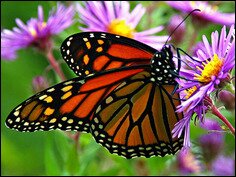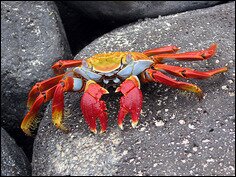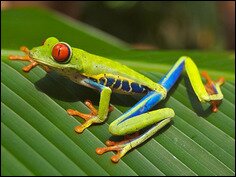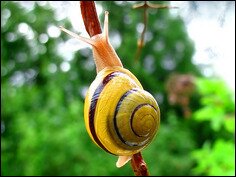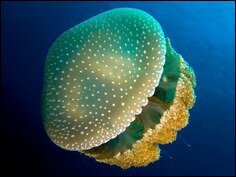Feeding Behavior
Current Category: Feeding Behavior.
The world over, animals and plants rely on feeding of some sort. Energy and nutrients need to travel from the outside of their bodies to the inside, to sustain the chemical reactions that we call life. From poo-eating detritivores to the finest restaurant critics, everything eats! Let’s have a look at how.
 Symbiotic relationship between ants & aphids. Photo by Matt Cole.
Symbiotic relationship between ants & aphids. Photo by Matt Cole.
Bait Ball
A bait ball is the last-ditch attempt by a school of fish to avoid predators, like sharks and dolphins. However, this tactic doesn’t always work, as the predators often end up treating the ball like the world’s fastest (and freshest) sushi conveyor belt!
Scavenger
Even the word scavenger sounds revolting, and we see scavengers as dirty and low, like flies, vultures and hyenas. They are, however, absolutely necessary to the food chain and the health of the planet, as they remove rotting plant and animal matter from the environment, recycling it as safer and more usable material.
 Saltwater Crocodile (Crocodylus porosus). Pic by Molly Ebersold.
Saltwater Crocodile (Crocodylus porosus). Pic by Molly Ebersold.
Apex Predator
An apex predator is one that is at the top of its particular food chain – it has no natural enemies or predators of its own. While we might see them as domineering and selfish creatures, like sharks, wolves and even humans, apex predators are essential to the environment and to biodiversity.
Avivore
An avivore is a carnivorous animal that preys just on birds. A lot of the birds of prey eat other birds, and they catch them while in mid-air, which is no mean feat, requiring superb eyesight, coordination and strength. Some mammals are also avivores, like the caracal, a medium-sized cat and the greater noctule bat of southern Europe.
 Malabar grouper (Epinephelus malabaricus) is a suction feeder. Photo taken by Jon Hanson, UK.
Malabar grouper (Epinephelus malabaricus) is a suction feeder. Photo taken by Jon Hanson, UK.
Aquatic Predation
Aquatic predation is the many different feeding methods that underwater animals use to eat. There are lots of different methods, like suction feeding, which some fish use to suck large amounts of water, containing small prey animals, into their mouths. There’s also ram feeding and filter feeding, find out more below.
Cannibalism
Cannibalism is an unusual feeding practice which involves the eating of a member of the same species. In humans, cannibalism is only ever a last resort in times of desperate starvation, or an occasional ritualistic practice. Cannibalism happens in the rest of the animal kingdom as well, especially among spiders, where the female spider often eats the male if she doesn’t fancy him – and sometimes when she does! Another example is the praying mantis.
 A Bengal Tiger (Panthera tigris tigris) eating an Indian Pangolin. Photo by Dibyendu Ash.
A Bengal Tiger (Panthera tigris tigris) eating an Indian Pangolin. Photo by Dibyendu Ash.
Carnivore
Carnivores are animals that eat only, or mostly, meat and other animals. Carnivores are high up in the food chain alongside omnivores, which eat meat and plant matter. A sub-classification of carnivores is the hypercarnivore, a type of animal that has a diet consisting of at least 70% meat. Examples of hypercarnivores are sea stars and big cats.
Commensalism
Commensalism is a relationship between two different organisms in which one partner benefits from the other, but doesn’t harm it. A good example of commensalism include barnacles and whales – the barnacles live on the whale’s skin and eat the food particles that float around the whale as it feeds. Some birds follow the trails of army ants, feasting on the insects stirred up from the forest floor by their marches.
 A female Oriental Latrine Fly feedings on animal feces. © Muhammad Mahdi Karim.
A female Oriental Latrine Fly feedings on animal feces. © Muhammad Mahdi Karim.
Coprophagy
Coprophagy is the consumption of fecal matter. It is commonly seen in dogs and cats but it is quite common in the animal kingdom as well. Even some plants practice them. Humans do practice coprophagy but in most cases, it is due to mental illness than anything else.
Deposit Feeding
Deposit feeders are very common indeed, and deposit feeding is a major way of life on this planet. These feeders catch (if that’s the right word) by sifting through soil and filtering out the useful bits. To make it as a deposit feeder you need to live in a popular area – desert sand won’t do much for you! The best-known examples of deposit feeders are earthworms, fiddler crabs and various types of insect larvae.
 Pixie’s parasol is a decomposer. They produce enzymes that can breakdown lignin in woods. Picture by JJ Harrison.
Pixie’s parasol is a decomposer. They produce enzymes that can breakdown lignin in woods. Picture by JJ Harrison.
Detritivore
Detritivores are very important parts of the food chain and the ecosystem, as they eat decaying plant, animal and fecal matter. These animals, like earthworms, millipedes and even the chicken, which may surprise you! Detritivores are different to scavengers, because scavengers will eat newly-dead animals of any size (think hyenas), whereas detritivores need the food to be small and preferably easy to eat.
Filter Feeding
Filter feeders filter water through specialized teeth or mouth parts, discarding the water and keeping hold of small animals or other food particles. The best-known examples of filter feeders include whale sharks, flamingos and krill. Filter feeders mostly aim for plankton and small crustaceans, and most are aquatic.
 Green Violetear. A hummingbird is example of a fluid feeder. © Mdf.
Green Violetear. A hummingbird is example of a fluid feeder. © Mdf.
Fluid Feeding
Fluid feeding is a very common feeding mode. These animals make their living by eating or drinking fluid from their prey animals or from the plants they feed from. Well-known, but not very popular, examples of fluid feeders are fleas, ticks and vampire bats. There are a few pleasant examples, like the hummingbird, but generally, fluid feeders are not well-regarded. Especially when you’re picking them out of your hair!
Geophagy
Geophagy is an unusual practice – eating dirt. We’ve all tried it as children, for a laugh or just to see what will happen. As adults, though, it is considered abnormal. Some doctors think geophagy is caused by mineral deficiencies, and others think it’s because of a psychological problem.
 An Anopheles stephensi mosquito feeding on human blood. © CDC.
An Anopheles stephensi mosquito feeding on human blood. © CDC.
Hematophagy
Vampires are the best-known hematovores, as well as the most glamorous. However, most animals that fall into the blood-eating category are quite reviled. We’re talking ticks, leeches, vampire bats and mosquitoes. All hematovores have special compounds in their saliva that overcome clotting and irritation, so that they can feed for as long as they need to without alerting their victims.
Herbivore
Herbivores are animals that eat plant materials like leaves and grasses. A lot of mammals (ruminants) are herbivores but you can also find birds and insects that eat plant materials as well. Some herbivores are specialized eaters or prefer to eat a certain part of a plant. Examples are like termites, which like to eat the woody part of a plant. Some prefer nectar and others prefer fruits.
 A brown robber fly eating a hoverfly. Photo by fir0002.
A brown robber fly eating a hoverfly. Photo by fir0002.
Insectivore
An insectivore is an animal that eats insects. Insects are a good source of protein and calories for all sorts of creatures the world over. The thing about bugs is that, although most of them are small, there are quite literally trillions of them! A lot of the planet’s biomass is made of bugs, so if you’re a bird or a bat, they’re an easy meal. Some animals, like bats, are true insectivores, as they eat little else. Other animals use insects only as part of their diets.
Kleptoparasitism
Kleptoparasitism means parasitism by theft. One animal steals the prey, or other foodstuff, that another animal has made the effort to source or catch. This form of feeding happens throughout the animal kingdom, and well-known examples of kleptoparasites are the hyenas, who are notorious for stealing from lions, and even from each other.
 A European honey bee gets nectar from an Aster flower while the flower gets help in pollination. Photo taken by John Severns.
A European honey bee gets nectar from an Aster flower while the flower gets help in pollination. Photo taken by John Severns.
Mutualism
In a mutualistic relationship, the two species involved benefit from each other. There are two types of this relationship – long term and physically very close. The benefits of this relationship include the supply of energy, nutrition, transportation and protection. Examples include the bacteria that we as humans need to digest food, and the relationship between flowering plants and bees.
Parasitism
Parasites are horrible. They come along and take what they need from their host, giving nothing in return except for ill health, irritation or worse. Tapeworms are a feared human parasite – they cause discomfort and deprive the host of valuable nutrition by stealing it right out of the gut. Fleas are another bad parasite. They are unpleasant and irritating, but they can also spread diseases.
 Animation: example phagocytosis. © Brooklyn College, New York.
Animation: example phagocytosis. © Brooklyn College, New York.
Phagocytosis
Phagocytosis occurs when cells ingest solid matter. It can be either food particles or a bacterium, but only certain types of cell, or certain types of animal (like the amoeba) can actually perform phagocytosis. These phagocyte cells get the particles by engulfing and absorbing them.
Symbiosis
Symbiosis describes a relationship between two or more different species that live in the same environment, a relationship that usually benefits both or all parties in some way. A well-known example of symbiosis is the relationship between the sea anemone and the clownfish. The clownfish gets protection by living in the venomous tentacles of the anemone, while the anemone is protected from the polyp-eating fish that would eat its tentacles if the clownfish didn’t chase them away. The anemone also gets to eat clownfish poo – what’s not to like?



